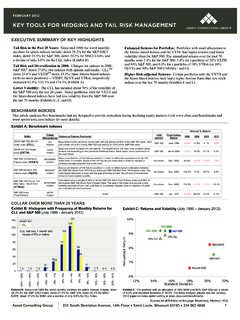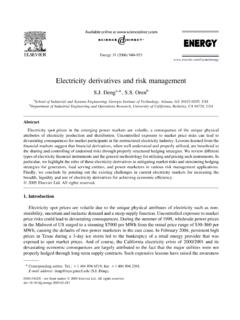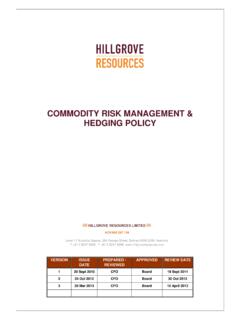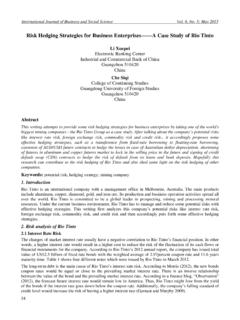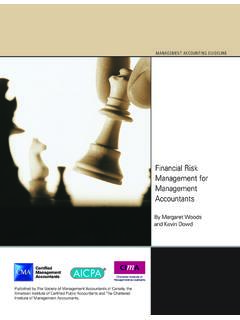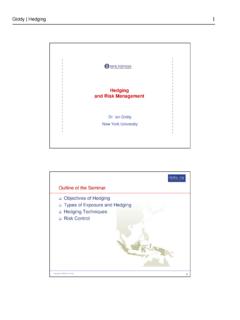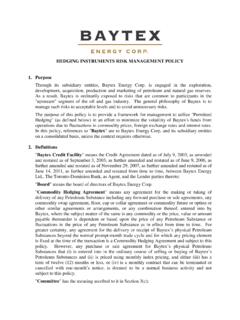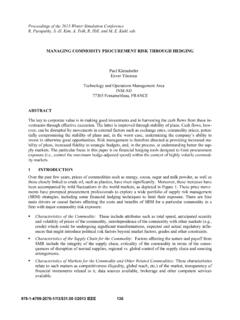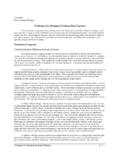Transcription of Implementing Long Volatility Exposures for Hedging
1 Implementing long Volatility Exposures for Hedging1 December 2016/ Risk management . Spectrum of Downside Protection & long Volatility Strategies. long Volatility long Volatility Exposures for Hedging2/Risk ManagementImplementing long Volatility Exposures for Hedging3/ Risk management : risk is a multi-faceted, multi-horizon, concept that focuses on the possibility of shortfall relative to expectations (journey) and outcomes (destination). This definition of risk indicates a spectrum of potential sensitivities across a range of time horizons rather than a single risk level (floor) for most schemes. Objective: the objective of the Risk management is broader than simply the management of low frequency end of horizon events (mission impairment) and accordingly extends from the left shoulder of the distribution to the tail.
2 Such a wide envelope of risk management requires clarity around discrete investment strategies and how such strategies intersect with the facets of ManagementImplementing long Volatility Exposures for Hedging4 Source: Willis Towers Watson, 2012 The Wrong Type of Snow . /Reduce Deadweight Cost At times of stress, investors are often forced to incur deadweight costs to adjust the risk exposure of their portfolios. This rebalancing is accentuated for strategies with inflows insufficient to meet financing requirements (mature DB Portfolio). The deadweight adjustment first takes the form of reducing risks by liquidating the most liquid assets held to minimize transaction costs. By diminishing the supply of liquid assets early on, the deadweight adjustment costs are amplified if stress continues as the price of liquidity for these less liquid assets soars.
3 Maintain Risk Exposures long Volatility Exposures enable clients to run an appropriate target level of risk. Resilient Exposures enable the clients to have enough risk to generate wealth but not so much that mission is likely to be permanently impaired. Mission Impairment The Mission is the long term value creation proposition of the portfolio embodied within the investment objectives. Mission impairment is the risk that the portfolio s end horizon objectives are not met and the Portfolio(s) does not survive the journey . Objective of long Volatility Risk management StrategiesImplementing long Volatility Exposures for Hedging5 Note: Select text in this section taken from: Alankar, A; DePalama, M; & Scholes, M (2012) An Introduction to Tail Risk Parity , AllianceBernsteinWhite Paper. /We have spent significant time with our stakeholders clearly defining the objectives of their long Volatility approach.
4 Facets of Risk ManagementImplementing long Volatility Exposures for Hedging6 SizeLikelihoodImpactSignificance Possible outcomes which fall below a threshold which ultimately comprises mission The probability of the events associated with those outcomes. Impact on the portfolio s investment objectives. An assessment of the impact of risk event on the portfolio s mission including the effect of the stakeholder responses. /Decomposing strategies by the facets of risk provides greater clarity for clients allocating to defensive risk management strategies. Delineating Risk management StrategiesImplementing long Volatility Exposures for Hedging7 Source: TCorp. Size (Equity Market Decline)LikelihoodImpactSignificance6 Months12 MonthsResilient Exposures -5%-10%FrequentIntra HorizonModerateConvex & long Volatility Exposures -10%-20%LowIntra & End HorizonHighTRH Expsoures-20%-25%Very LowEnd HorizonImpairment/Spectrum of Downside Protection & long Volatility StrategiesImplementing long Volatility Exposures for Hedging8/ Implementing long Volatility Exposures for HedgingSpectrum of Downside Protection: Is the Problem Insufficient Diversification or Risk management ?
5 MomentumLong Volatility StrategiesTail Risk Hedging (TRH)Incumbent: Strategic Asset Allocation with Dynamic Adjustments Risk defined as Volatility . By equalising risk the strategy seeks to enhance diversification Risk forecasts are more reliable than return forecasts. Volatility TargetingPortfolio Insurance Risk isn t forecast Volatility . Na ve versions assume stationarity of correlation between regime assets. Incomplete nature of asset markets means not all regimes can be hedged. Leverage can transform a temporary impairment ( , price Volatility ) into a permanent impairment of ParityInputs: Volatility & CovarianceVolatility, Covariance & ReturnDrawdown / Pain ThresholdVolatilityDefinition:Issues: Risk defined as Volatility . Assets included based on positive expected return (risk premia).
6 Trade off between assets determined by the portfolio s aggregate risk and return preferences. Risk isn t forecast Volatility . High real return targets may mean that portfolios are less diversified as clients trade return for diversification. The cost of the crisis and subsequent fiscal and monetary methadone has been reduced diversity. Optimisation of portfolio sensitive to inputs. DAA information ratio low. Risk defined as absolute drawdown. Convex strategies seek to perform in environments where client s market portfolio of growth Exposures underperform. Pattern of returns more important than equilibrium assumptions of return. Low returns (in normal environments) create significant opportunity costs. Allocation to strategies needs to be meaningful to have impact. Given the dependence on skill (persistent negative correlation & low theta) such strategies are rare, non-scalable and (if located) expensive.
7 Risk defined as absolute drawdown Hedge catastrophic loss through use of options. TRH may be judgmental or deterministic. Clear transparent hedge. Significant explicit cost creates behavioural challenges. Implementation hurdles when executed in size or over short horizons. Risk defined as outcome below a dollar value (predefined floor). Dynamically creates a cash cushion using futures to offset large market losses. The level at which risk exposure is curtailed is independent of Volatility . Portfolio Insurance is path dependent. For the same past returns, risk asset allocation can vary depending on distance of asset value from floor. Crystallisation of losses provides no opportunity to recover. Portfolio Insurance may bring forward mission impairment . Weak protection in sharp drawdowns ( ).
8 Risk defined as Volatility . Volatility (spot or term structure) used to modulate the absolute level of risk. Volatility markets have informational content and are seen as a leading indicator of returns. Risk isn t observed Volatility (spot or term structure). Targeting Volatility may lead to smoothing returns but may not limit drawdown. Volatility does not always correctly predict drawdowns ( rational Volatility markets / irrational equity markets ) and provides a number of false positives. Strategies decompose price series into trend and noise and seek to capture trends . Observed positive skew. Empirically strategy is similar to a straddle (a call and a put), and hence offers exposure to rising market Volatility . Momentum strategies are vulnerable to a counter-trend shock. Contracting Volatility and range bound environments are not conducive to Momentum strategies.
9 Designed to Address:Insufficient Diversification-Incomplete Risk ManagementInsufficient Diversification & Incomplete Risk ManagementDynamic Beta ModulationDiversificationAsymmetric / ConvexStock Replacement Targets a linear return with high equity beta. Replace outright long Exposures with Delta and Vega positions. Complex asset allocation problem how do we manage within the context of the asset allocation? Strategy is the inverse of buy-write premium and despite high skew may provide a meaningful drag to portfolio / SkewAsymmetric Risk Substitution9/ long Volatility StrategiesImplementing long Volatility Exposures for Hedging10/ Implementing long Volatility Exposures Optimisation Process: trade-off between Convexity, Basis (Timing), Basis (Assets the client is seeking to hedge) and Cost (Theta / Bleed).
10 There is no free lunch. Basis Can t Be Removed: the absence of Arrow securities and market incompleteness ( , Australia) require the assumption of tracking error within the long Volatility portfolio. long Volatility Strategies Exists as Portfolio management Tool: requirement to frame the strategies within the context of broader asset Official Use OnlyImplementing long Volatility Exposures for Hedging11/ Implementing long Volatility Exposures : Manager StrategiesLong Volatility as a Defensive / Fixed Income Substitute The cost of the crisis has been reduced diversification. Fixed income is no longer the anchor to the windward : bonds at low yields offer reduced potential positive skew at the portfolio level (with bonds bound by the cash-and-carry constraint). Further, as noted by Fisher Black ( Interest Rates as Options , 1995) bonds at low yields become short Volatility instruments.
